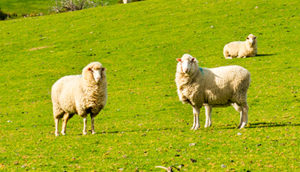Read the latest information on
Foot-and-mouth disease
 The concept of social distancing will likely go down in history as one of the main things by which we remember 2020. Over the course of the year, keeping an appropriate distance between yourself and others has been touted as a key step in limiting the transmission of diseases between individuals.
The concept of social distancing will likely go down in history as one of the main things by which we remember 2020. Over the course of the year, keeping an appropriate distance between yourself and others has been touted as a key step in limiting the transmission of diseases between individuals.
There are some significant parallels between human, animal and plant disease outbreaks, in terms of how they are managed. This is because the same basic principles are at play, regardless of what species the disease affects.
Just as travelers spread COVID-19, mixing different groups of animals is one of the most common ways that livestock diseases and parasites move and establish in new areas. According to veterinarian and Animal Health Australia’s Senior Manager Biosecurity, Dr Rob Barwell, this makes the introduction of new animals to your property a huge risk pathway for bringing in something you didn’t have to previously manage.
“Managing livestock diseases is a fact of life, but of course prevention is much easier than curing or eradicating an outbreak once it gets going,” Dr Barwell explained.
“Fortunately, there are some really simple steps you can take to minimise the risks that purchasing new livestock can pose to your business.”
The first step is to seek assurance that the livestock are free of diseases of major concern to begin with. If you’re grazing cattle, sheep, goats or alpacas, asking your vendor for an Animal Health Declaration is an easy way to assess how the previous owner has managed animal health in their flock or herd.
Isolating or ‘quarantining’ new arrivals in a designated yard or paddock before allowing them to mix with your existing stock is also a powerful way to ensure you catch any disease incursion at the gate.
“Most diseases will have a period between infection and first signs, where the vendor, the transporter or you may not realise the animal is sick,” Dr Barwell says.
“Holding them away from your existing livestock for a couple of weeks gives them plenty of time to start showing signs of illness before they have a chance to infect the rest of your animals.
“It also gives you time to notice any weed seeds which may have passed through the animal and are now sprouting in your yard, or pick up signs of lice, ticks and other parasites.”
Diseases and parasites can sometimes be picked up from wild animals or in the environment and can spread undetected. However, transmission between livestock often requires close contact, so there’s a limit to how quickly things can spread.
For this reason, pulling a sick animal out of the mob and holding them in a ‘hospital’ yard while you treat it, or follow up with the vet, can mean the difference between a few isolated cases and a big outbreak.
“For grazing enterprises, wide, open spaces can work to your advantage in stopping or slowing disease spread,” Dr Barwell explained.
“Enforcing a little social distancing between your livestock at the right time can prevent a small problem becoming much bigger.”
Find out more about managing new stock and other farm inputs via the Farm Biosecurity website.